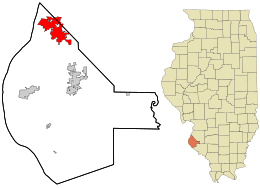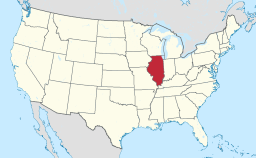Columbia, Illinois
| Columbia | |
| City | |
| Motto: Good for business, good for life | |
| Country | United States |
|---|---|
| State | Illinois |
| Counties | Monroe, St. Clair |
| Elevation | 709 ft (216 m) |
| Coordinates | 38°26′57″N 90°12′31″W / 38.44917°N 90.20861°WCoordinates: 38°26′57″N 90°12′31″W / 38.44917°N 90.20861°W |
| Area | 10.48 sq mi (27 km2) |
| - land | 10.41 sq mi (27 km2) |
| - water | 0.07 sq mi (0 km2) |
| Population | 9,707 (2010) |
| Founded | 1859 |
| Mayor | Kevin Hutchinson |
| Timezone | CST (UTC−6) |
| - summer (DST) | CDT (UTC−5) |
| Postal code | 62236 |
| Area code | 618 |
|
Location in Monroe County and the state of Illinois.
|
|
|
Location of Illinois in the United States
|
|
|
Website: www |
|
Columbia is a city in Monroe and St. Clair counties in the U.S. state of Illinois, about 12 miles (19 km) south of St. Louis, Missouri. The population was 9,707 at the 2010 census.
The first white settlers to come to the area of Columbia, Illinois, were Frenchmen in the mid-17th century. They named the area in which Columbia was founded L'Aigle, which is French for "The Eagle."
In the mid-18th century, the British took over the territory until the Revolutionary War forced them out of the area. The colonial American settlers soon arrived in the early 1780s and established the first permanent settlements in the area of Columbia, Fort Whiteside and Fort Piggott. Both frontier forts were of log construction and were used to protect the settlers against Indian raids.
In 1820, Columbia was plotted out as a town and built on bluffs 500 feet above sea level to protect against the flooding of the Mississippi River. Columbia is a poetic name for the United States.
Germans began immigrating to the area around 1833, with the majority coming in the 1840s. United States land agents had traveled to Germany to sell land to emigrating Germans. When the immigrants arrived in the United States, they traveled immediately to their own parcels of land.
Entering the United States through New Orleans, these Germans went up the Mississippi River to St. Louis, Missouri. They settled in the general region, including the Columbia area. The ground was not expensive, harvests were rich, and the climate was perfect for growing grain. German thrift, tenacity, and industriousness changed the character of Columbia from a pioneer settlement to a thriving community. The hard-working nature of the early immigrants had a direct influence on the town's present prosperity.
In the early 19th century, the American landowners in the Columbia area often hired the German immigrants who were not landowners as farmhands. Money was short, so they were given land as payment. Soon, most of the land belonged to the Germans.
In 1859, Columbia was incorporated as a town as a result of the growth from German immigration. In 1868, the first railroad tracks were laid in Columbia, and the town continued to grow and develop. In 1927, Columbia became a city.
...
Wikipedia



